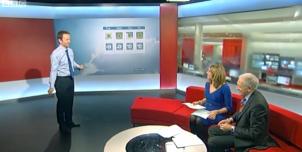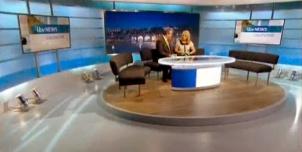Full Freeview on the Emley Moor (Kirklees, England) transmitter
| Google Streetview | Google map | Bing map | Google Earth | 53.611,-1.666 or 53°36'41"N 1°39'57"W | HD8 9TF |
The symbol shows the location of the Emley Moor (Kirklees, England) transmitter which serves 1,550,000 homes. The bright green areas shown where the signal from this transmitter is strong, dark green areas are poorer signals. Those parts shown in yellow may have interference on the same frequency from other masts.
This transmitter has no current reported problems
The BBC and Digital UK report there are no faults or engineering work on the Emley Moor (Kirklees, England) transmitter._______
Digital television services are broadcast on a multiplexes (or Mux) where many stations occupy a single broadcast frequency, as shown below.
64QAM 8K 3/4 27.1Mb/s DVB-T MPEG2
DTG-12 QSPK 8K 3/4 8.0Mb/s DVB-T MPEG2
H/V: aerial position (horizontal or vertical)
Which Freeview channels does the Emley Moor transmitter broadcast?
If you have any kind of Freeview fault, follow this Freeview reset procedure first.Digital television services are broadcast on a multiplexes (or Mux) where many stations occupy a single broadcast frequency, as shown below.
64QAM 8K 3/4 27.1Mb/s DVB-T MPEG2
DTG-12 QSPK 8K 3/4 8.0Mb/s DVB-T MPEG2
H/V: aerial position (horizontal or vertical)
Which BBC and ITV regional news can I watch from the Emley Moor transmitter?

BBC Look North (Leeds) 1.9m homes 7.4%
from Leeds LS9 8AH, 22km north-northeast (22°)
to BBC Yorkshire region - 56 masts.

ITV Calendar 1.9m homes 7.4%
from Leeds LS3 1JS, 22km north-northeast (16°)
to ITV Yorkshire (Emley Moor) region - 59 masts.
All of lunch, weekend and 80% evening news is shared with Belmont region
Are there any self-help relays?
| Derwent B | Active deflector | 74 homes | |
| Derwent C | Active deflector | (second level) | |
| Dunford Bridge | Active deflector | 14 km S Huddersfield | 15 homes |
| Hmp Leeds | Transposer | 30 homes | |
| Thixendale | Transposer | 25 km ENE York | 40 homes |
How will the Emley Moor (Kirklees, England) transmission frequencies change over time?
| 1956-80s | 1984-97 | 1997-98 | 1998-2011 | 2011-13 | 5 Feb 2020 | ||||
| VHF | B E T | B E T | B E T | B E T | W T | ||||
| C10 | ITVwaves | ||||||||
| C32 | com7 | ||||||||
| C33 | SDN | ||||||||
| C34 | com8 | ||||||||
| C36 | ArqA | ||||||||
| C37 | C5waves | C5waves | |||||||
| C39 | _local | ||||||||
| C41 | C4waves | C4waves | C4waves | BBCB | BBCB | ||||
| C44 | BBC1waves | BBC1waves | BBC1waves | D3+4 | D3+4 | ||||
| C47 | ITVwaves | ITVwaves | ITVwaves | BBCA | BBCA | ||||
| C48 | ArqB | ArqB | |||||||
| C51tv_off | BBC2waves | BBC2waves | BBC2waves | SDN | |||||
| C52tv_off | ArqA | ||||||||
| C55tv_off | com7tv_off | ||||||||
| C56tv_off | LLS |
tv_off Being removed from Freeview (for 5G use) after November 2020 / June 2022 - more
Table shows multiplexes names see this article;
green background for transmission frequencies
Notes: + and - denote 166kHz offset; aerial group are shown as A B C/D E K W T
waves denotes analogue; digital switchover was 7 Sep 11 and 21 Sep 11.
How do the old analogue and currrent digital signal levels compare?
| Analogue 1-5 | 870kW | |
| SDN, ARQA, ARQB, BBCA, D3+4, BBCB | (-7dB) 174kW | |
| com7 | (-12dB) 54.8kW | |
| com8 | (-12.3dB) 51.2kW | |
| Mux 1*, Mux 2*, Mux B*, Mux C* | (-19.4dB) 10kW | |
| Mux A*, LLS | (-22.4dB) 5kW | |
| Mux D* | (-23.4dB) 4kW |
Which companies have run the Channel 3 services in the Emley Moor transmitter area
|
|
Wednesday, 15 February 2012
Tim Searle: I don't know the answer to your questions, perhaps one of the pros can shed some more light on it.
It is speculation on my part that the FEC change on the three multiplexes in question is the reason that they are no longer working on your TV.
| link to this comment |
Thursday, 16 February 2012
M
Mike Dimmick2:34 PM
Tim Searle: There are five parameters for DVB-T transmission:
- Bandwidth
- Number of carriers/symbol time ('Mode')
- Modulation
- Forward Error Correction rate (FEC)
- Guard Interval
The bandwidth is the range of frequencies used for each multiplex. In the UK, and in the UHF band in Europe, this is 8 MHz to match the width of an analogue transmission.
The symbol time, which implies the number of carriers, is the guaranteed number of time ticks a pattern of signals (a 'symbol') is on air before it changes to the next pattern. Before switchover this was 2K, after it is 8K.
Modulation indicates how many different values a carrier can have. QPSK is four (two bits), 16QAM 16 (four bits), 64QAM 64 (six bits).
Forward Error Correction is a measure of the proportion of bits that are input and output compared to the number carried on air. Supported values are 1/2, 2/3, 3/4, 5/6 and 7/8.
The guard interval is some extra time, as a proportion of the symbol time, that the symbol is held for, to allow for echoes or multiple synchronized transmitters using the same frequency. The values are 1/4, 1/8, 1/16 and 1/32. All UK transmissions currently use 1/32. The further away an echo is expected to come from, the more time is needed to ensure it doesn't fall into the guaranteed symbol time.
At Emley Moor, all SD transmissions use an 8 MHz bandwidth, 8K mode, 64QAM modulation and a 1/32 guard interval. The PSBs use 2/3 FEC rate, while the COMs now use 3/4. It gives more capacity, but is less robust - it needs more signal, compared to noise and interference, than the PSB mode.
You shouldn't actually need to tell the box all this information, as it is all carried in many Transmission Parameter Signalling carriers that repeat many, many times per second. They use a very simple robust encoding which should be receivable even if nothing else is, and the same encoding is used whatever the other parameters (OK, for different numbers of carriers, and different bandwidths, they are found at different frequencies and held for a different length of time).
HD uses DVB-T2 which has a few more parameters, and a few more values for the parameters given, but the basics are still the same. Fully described, the HD transmissions are DVB-T2 8 MHz, 32K extended mode, 256QAM rotated, FEC 2/3, GI 1/128, Pilot Pattern 7. It requires roughly the same signal strength/quality as the SD PSB muxes.
Most boxes cope with a change in modulation depth, FEC and guard interval without needing a retune, but yours obviously doesn't. Since it appears with 100% quality in the Manual Retune screen with the values set to Auto, it can probably pick up the values from TPS when tuning, it just doesn't pick them up when you select a previously-stored service. It might take slightly longer to change channels if it had to wait to check TPS, I suppose.
| link to this comment |
Friday, 17 February 2012
D
David Mansell4:12 PM
Todmorden
I get Freeview via the Todmorden relay. I noticed recently, while scrolling the channel list, that the two "Rabbit" channels have vanished from my list. I'm not going to miss them but does that mean we might get another couple of channels to replace them? ITV3 and 4 would be nice and make up a bit for the scant choice that those of us on Freeview "Lite" get.
| link to this comment |
David's: mapD's Freeview map terrainD's terrain plot wavesD's frequency data D's Freeview Detailed Coverage
Monday, 27 February 2012
David Mansell: The rabbit channels are text services, if they are removed they will not provide the capacity even 5% of an additional television channel.
In addition, the law says there has to be 5% text services on the Mux 2/PSB2 multiplex.
| link to this comment |
D
David Mansell4:26 PM
Todmorden
They've reappeared anyway! I would willingly sacrifice any of the +1 channels for something more interesting. I can't see the need for them when virtually everybody has hard drive recorders these days. I still find it iniquitous that those of us who cannot pick up directly from the main transmitters are given such a derisory choice of programmes.
| link to this comment |
David's: mapD's Freeview map terrainD's terrain plot wavesD's frequency data D's Freeview Detailed Coverage
Ron Lake
11:17 PM
Wakefield
11:17 PM
Wakefield
David Mansell, Unfortunately it is all about MONEY. Whatever is popular will attract advertisers (revenue), and of course the higher population will give them the most exposure. Imagine what the licence fee would be if we had to directly pay for all these channels. The fact that we pay through the nose for them on the product prices seems to be missed by many.
| link to this comment |
Ron's: mapR's Freeview map terrainR's terrain plot wavesR's frequency data R's Freeview Detailed Coverage
Tuesday, 28 February 2012
D
David Mansell4:27 PM
Todmorden
As far as I know we all pay the same licence fee, so I can't see that that's a relevant argument.
| link to this comment |
David's: mapD's Freeview map terrainD's terrain plot wavesD's frequency data D's Freeview Detailed Coverage
Wednesday, 29 February 2012
Ron Lake
12:50 AM
Wakefield
12:50 AM
Wakefield
The relevance is that the fee goes to BBC only, all commercial channels are supported by advertisers. Whilst the BBC are obliged to feed the whole licenced community, commercial channels will target the largest audience.
| link to this comment |
Ron's: mapR's Freeview map terrainR's terrain plot wavesR's frequency data R's Freeview Detailed Coverage
D
David Mansell4:15 PM
Todmorden
No that's not relevant. The people who can receive their signal direct from main transmitters receive the whole gamut of channels ; people who receive Freeview from relays only get a very restricted choice. Both sets of people pay the same licence fee. The difference is where you live, not what you pay. I think the commercial channels are very short-sighted not to provide their better channels to relays. ITV2 is such rubbish that I have never watched it, and if it has derisory viewing figures, the advertising rates must be low.
| link to this comment |
David's: mapD's Freeview map terrainD's terrain plot wavesD's frequency data D's Freeview Detailed Coverage
Ron Lake
11:44 PM
Wakefield
11:44 PM
Wakefield
Presume you get all BBC transmissions David, which is what your licence fee pays for, the rest is 'FREE' view.
I have tried to explain this and I am not prepared to get into a flame war about it.
My last word on the subject.
| link to this comment |
Ron's: mapR's Freeview map terrainR's terrain plot wavesR's frequency data R's Freeview Detailed Coverage
Select more comments
Your comment please!





